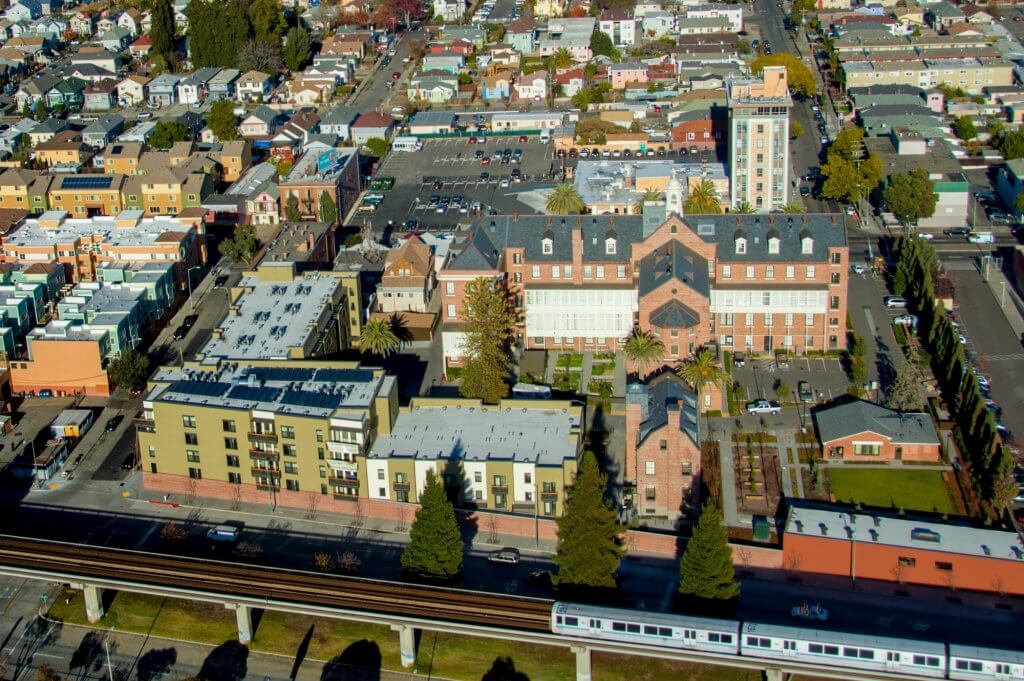How AB 1401 May Impact Residential Parking Requirements
Published On April 13, 2021
As California grapples with a continued housing crisis, policymakers are turning their attention to the high cost to produce new homes. Several reports have detailed how expensive building in the Golden State has become, including recent work we’ve done here at the Terner Center to document and analyze the costs of both market-rate and affordable housing development. These escalating costs directly translate to higher rents and home prices, and erode the effectiveness of our affordable housing subsidies. To address this issue, lawmakers have introduced several pieces of legislation that could meaningfully reduce the cost to build new homes. However, one bill in particular stands out: Assembly Bill 1401. This bill, introduced by Assemblymember Laura Friedman, directly addresses requirements for on-site parking, which are some of the most expensive components of new home development. Specifically, AB 1401 would prohibit cities from enforcing parking requirements on residential and commercial properties, a bold proposition in a state where most new development over the past 50 years has been shaped by an overriding prioritization of easy automobile access. The rise of ride-sharing, delivery services, and greater work-from-home flexibility are all shifting households’ auto-dependency. More importantly, a growing consensus points to the need to utilize infill development and expand alternative transportation options in order to limit car usage and related greenhouse gas emissions. AB 1401 has broad implications for achieving a variety of positive housing, economic, and environmental outcomes.
How would the passage of AB 1401, as currently drafted, impact housing in California? This short analysis attempts to answer this question by leveraging existing research conducted by the Terner Center. Specifically, we examine existing parking requirements throughout the state using our 2019 Terner California Residential Land Use Survey (TCRLUS). The survey, conducted in 2017 and 2018, includes responses from 252 cities and 19 unincorporated county areas in the state, and includes insights on a range of questions on local zoning, development approval processes, affordable housing policies, and rental regulations. For parking requirements, our survey asked for general information regarding single-family and multifamily projects. It should be noted that parking requirements may vary across an entire jurisdiction given different zoning designations, overlays, or other factors, and our survey does not capture such variability.
We also look at the existing literature on parking, from the cost to provide parking to the implications of parking across other issue areas. Lastly, we explore how AB 1401 might impact Density Bonus Law usage.
Background
While AB 1401 is the most sweeping in scope, a few relatively recent California laws have also limited the amount of parking required for certain housing development. For example, projects eligible for Senate Bill 35 (Wiener, 2017) streamlining are exempt from parking requirements if they are near transit. SB 35 also limits parking requirements for eligible projects to one space per unit in all other areas. AB 744 (Chau, 2015) limits local parking requirements to 0.5 spaces per bedroom for housing near transit that uses the state density bonus program or is 100 percent affordable to lower-income households. AB 1763 (Chiu, 2019) prohibits parking requirements on supportive housing.
In addition to statewide reforms, some localities have also significantly reduced or eliminated parking requirements altogether. For example, the city of Berkeley voted in January 2021 to eliminate most parking requirements after concluding that existing off-street parking spaces are nearly 50 percent vacant. Other cities to have reduced or eliminated parking requirements include San Francisco, Oakland, and San Diego.
Limiting parking in the manner proposed in AB 1401 could be impactful for several reasons. Parking is a significant factor driving up the costs to build new homes. For example, our 2020 report on the costs of Low-Income Housing Tax Credit (LIHTC) developments in California found that parking spaces add significantly to the total cost. In an examination of 678 new-construction 9% LIHTC-funded developments built in California between 2008 and 2019, the presence of structured parking added nearly $36,000 per unit. For a 100-unit building required to include an on-site parking structure, this would mean that roughly $3.6 million of the project cost goes to parking. Other analyses have found even greater costs associated with on-site parking. For example, research on home sale prices in San Francisco found that single-family and condominium units were 10 percent more expensive if they included off-street parking.1 Another study showed that each parking space added per unit of housing in urban areas increased the development cost per unit by 12.5 percent.2
Parking requirements also correlate with less permitting and construction of multifamily housing and higher housing costs overall. Data from the TCRLUS revealed that less multifamily housing was built in California cities that had higher parking requirements between 2010-17. These types of restrictions are associated with limited housing supply, which results in higher prices and lower rates of homeownership and household formation among young people aged 25-34.3 TCRLUS data also showed that parking minimums are one among a suite of regulatory mechanisms that California jurisdictions use to discourage higher density development. Prohibitions against density are strongly associated with less permitting, especially permitting of multifamily housing.4
Minimum parking requirements have been shown to increase the cost of development, which therefore raises rents and home prices.5 Recent research demonstrated that the costs of building and providing parking are passed on to consumers and that mandating parking discourages the construction of small housing units that may be more affordable to lower-income households.6
Parking requirements have also been linked to a variety of negative secondary impacts, in particular the environmental costs for cities. Parking contributes to the urban heat island effect and does not support any biodiversity. Land coverage by asphalt increases stormwater runoff, which raises the risk of flooding and causes higher pollution levels in freshwater systems.7Chemical compounds used to seal parking lots can seep into groundwater and freshwater systems, which contributes to pollution and decreases the health of these ecosystems.8 Because it encourages automobile usage, parking also hinders the effectiveness and usage of alternative forms of transit (public transportation, biking, etc.), increases congestion, and causes externalities like air pollution, noise pollution, and greenhouse gas emissions.9
AB 1401
AB 1401 was introduced by Assemblymember Laura Friedman, and currently includes three co-authors: Senators Scott Wiener and Nancy Skinner, and Assemblymember Alex Lee. As written, AB 1401 would prohibit cities from enforcing parking minimums for both residential and commercial developments if they are near high-quality transit.
Nothing in AB 1401 would preclude developers from including parking in their projects if they choose to do so. In most cases, we would expect that developers will most likely continue to offer some on-site parking given market demand from tenants as well as financial backers who see parking as necessary for project feasibility. However, the flexibility provided by AB 1401 may allow developers to offer less parking than would be otherwise required.
Findings
AB 1401 has substantial implications for parking requirements statewide.
Residential parking requirements are ubiquitous across California, according to the TCRLUS, which means that AB 1401 could significantly alter how much parking is built in new residential developments near transit. Nearly each responding jurisdiction reported having some parking requirements for both multifamily and single-family housing development. For multifamily projects, slightly over two thirds of jurisdictions require at least two parking spots for each unit of housing. On the other hand, just 14 percent of jurisdictions required just one parking space or less per unit.
In rare cases, some jurisdictions require more than two parking spaces per new two-bedroom unit of multifamily housing. For example, the city of San Juan Capistrano reported requiring 3 parking spaces per multifamily unit. Similarly, the city of Beverly Hills requires 2.5 spaces per multifamily unit.
Table 1. Multifamily Parking Minimums
| Parking Minimum per 2-BR unit of MF housing (# of Cars) | # of Municipalities | % of Municipalities |
| No parking min. required | 3 | 1.1% |
| 0.67 to 1 | 34 | 12.9% |
| More than 1 and less than 2 | 45 | 17.0% |
| 2 | 168 | 63.6% |
| More than 2 | 14 | 5.3% |
N=264
For single-family homes, minimum parking requirements are even higher. 94 percent of jurisdictions require at least two parking spaces per three-bedroom home, with eight percent requiring more than three parking spaces. Some cities require even higher amounts. For example, Cupertino, Costa Mesa, and Huntington Beach reported to us that they require 4 parking spaces per single-family home. Just 16 jurisdictions reported requiring one space or less per home.
Table 2. Single-Family Parking Minimums
| Parking Minimum per 3-BR unit of SF housing (# of Cars) | # of Municipalities | % of Municipalities |
| No parking min. required | 6 | 2.3% |
| 1 | 10 | 3.9% |
| 2 | 201 | 78.2% |
| More than 2 and up to 3 | 19 | 7.6% |
| More than 3 | 21 | 8.2% |
N=257
While AB 1401 would grant developers the option of forgoing the construction of parking in many places, developers may continue to include parking. Many respondents in our survey noted that developers rarely request variances for existing parking requirements. For example, for multifamily projects, 80 percent of jurisdictions reported that developers either seldom or almost never request variances from parking requirements. Similarly for single-family projects, 91 percent of respondents reported that developers seldom or almost never ask for parking variances. This signals that developers are generally able to make projects pencil with existing requirements. However, the lack of developer variance requests does not necessarily mean that they would not build less parking if they had the option, only that under current conditions, few are requesting permission from the city to do so. This could be a function of the difficulty of obtaining a variance, pushing developers to construct parking they may otherwise not build rather than jeopardize the progression of their project by going through the burdensome variance process.
Density Bonus usage is very limited statewide, but parking reductions are sometimes requested when the Density Bonus is used.
Some existing state programs provide avenues for developers to reduce the amount of required parking in a new project, and the passage of AB 1401 as currently written may impact the usage of these programs. For example, the state Density Bonus Law allows developers to gain concessions on requirements from local governments—such as lowering or eliminating parking requirements—in exchange for reserving a portion of their units at affordable prices. There is the potential that AB 1401 would incentivize developers to forgo utilizing the Density Bonus law. However, the TCRLUS finds that use of the Density Bonus Law is very limited statewide. 55 percent of respondents reported no Density Bonus Law usage from 2015 to 2017, and an additional 32 percent reported just 1 to 2 projects. Only 27 jurisdictions reported having at least one project utilizing Density Bonus Law.
At the same time, many Density Bonus projects do request parking reductions through the program. TCRLUS finds that reduced parking is the second most requested concession, (behind added density) with roughly 60 percent of jurisdictions with density bonus activity reporting that developers request parking reductions as part of the DB concessions. However, it is unclear if developers would eschew the density bonus altogether if AB 1401 passed, given that other incentives are also routinely sought after through the program. Concessions such as increased height and reduced impact fees were also reported in our survey, signaling that developers may continue to utilize the Density Bonus to access these other benefits.
It should also be noted that jurisdictions that reported higher levels of usage of Density Bonus law also reported that they have an inclusionary ordinance. This signals that even if developers in these jurisdictions decide to forgo the density bonus due to the passage of AB 1401, they would still be required to include some percentage of affordable units within the development. Of the 14 jurisdictions that reported five or more density bonus projects during the survey period, all but four reported that they also had mandatory inclusionary requirements in place.
Conclusion
AB 1401, as currently drafted, would significantly alter how much parking could be required in the majority of cities statewide. This has important implications for cutting the cost of new housing and reducing greenhouse gas emissions. However, because of consumer demand, many projects may continue to provide parking on-site regardless of AB 1401. Outside of areas with strong transit connections, many consumers may expect parking to be available to them, and even if residential developers prefer to build fewer parking stalls, in some cases, project lenders or investors may require more parking as a predicate to their investment. But AB 1401 would allow developers greater flexibility to adjust parking based on financial feasibility, rather than the requirements dictated by local regulations.
Endnotes
- Jia, W., & Wachs, M. (1999). Parking Requirements and Housing Affordability: Case Study of San Francisco. Transportation Research Record, 1685(1), 156–160. https://doi.org/10.3141/1685-20.
- Litman, T. (2014). Parking Requirement Impacts on Housing Affordability. Victoria Transport Policy Institute. https://www.vtpi.org/park-hou.pdf.
- Mawhorter, S. (2019). Housing Policies in California Cities: Seeking Local Solutions to a Statewide Shortfall. Land Use Working Paper Series. Retrieved from: http://californialanduse.org/download/Mawhorter_Housing_Policies_in_California_Cities.pdf.
- Monkkonen, P., Lens, M., & Manville, M. (2020). Built-Out Cities? How California Cities Restrict Housing Production Through Prohibition and Process. Terner Center for Housing Innovation Land Use Working Papers. http://californialanduse.org/download/MLM%20Built-Out%20Cities%202020.pdf.
- Shoup, D. C. (1999). The trouble with minimum parking requirements. Transportation Research Part A: Policy and Practice, 33(7), 549–574. https://doi.org/10.1016/S0965-8564(99)00007-5.
- Lehe, L. (2018). Minimum parking requirements and housing affordability. Journal of Transport and Land Use, 11(1), 1309–1321. https://www.jstor.org/stable/26622457.
- Davis, A. Y., Pijanowski, B. C., Robinson, K., & Engel, B. (2010). The environmental and economic costs of sprawling parking lots in the United States. Land Use Policy, 27(2), 255–261. https://doi.org/10.1016/j.landusepol.2009.03.002.
- Scoggins, M., McClintock, N. L., Gosselink, L., & Bryer, P. (2007). Occurrence of polycyclic aromatic hydrocarbons below coal-tar-sealed parking lots and effects on stream benthic macroinvertebrate communities. Journal of the North American Benthological Society, 26(4), 694–707. https://doi.org/10.1899/06-109.1.
- Sterner, T. (2003). Policy instruments for environmental and natural resource management. Resources for the Future.





